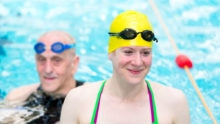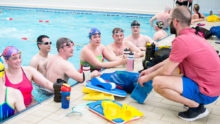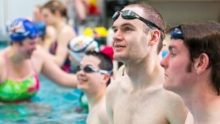
What are the differences between coaching pool and open water swimming?
August 10, 2017After speaking to participants and spectators at last month’s Swim England Open Water Festival, the IoS wrote an open water coaching article about the differences between coaching pool and open water swimming.
It turns out, there are quite a few! Scroll down to see some of the key things to take into account when coaching swimmers for open water.
8 Key Differences Between Coaching Pool And Open Water Swimming
- Teaching sighting
- Bilateral breathing is vital
- Practice of turning buoys
- Swimming in a group
- Keeping relaxed
- Endurance and conditioning
- Being adaptable to different swimming conditions
- Staying safe
Teaching Sighting
In open water swimming, there are no lane lines. So an important part of coaching newcomers to open water, assuming of course that they want to swim in a relatively straight line, is to get your swimmers to practice looking ahead or ‘sighting’ during their sessions.
Do this by having a marker in the distance to follow. You can get your swimmers to practice this in a pool if there are no lanes. Most find the disruption to their rhythm the hardest thing to get over but it’s only with practice that they can find a rhythm that works for them.
When sighting in open water, your swimmers should use key features, such as trees, unusual shaped embankment or buildings, instead of focusing on the buoy as, especially in rough water, these can move.
Bilateral Breathing
Breathing on alternative sides in training for open water events is crucial. Swimmers that breathe unilaterally can develop a stroke imbalance and veer to one side. Again not ideal when swimming in a straight line is hard enough already.
For those who don’t breathe bilaterally, this won’t feel very natural at first. But with practice it becomes more comfortable for the swimmer.
If your team are training solely for open water events, try and incorporate this in to sessions with drills or throughout workouts. You will also need to incorporate regular sighting in to this.
Turning Buoys
Most open water events will involve turning around a marker buoy, often four or five times a race. This sounds like it should be easy enough but after years of swimming in straight lines, some of your group will need a lot of practice at this.
There are also multiple techniques for turning buoys and some will take more time to master than others.
If you have space, put a marker out in the water or pool but make sure it’s deep enough that no one can touch the walls or bottom.
Swimming In A Group
Lots of people swimming together can be a bit of a shock for some. That may be putting it mildly.
If you have a squad of swimmers, it’s a really good idea to have them practise group swimming in one lane of the pool to help them get used to the feeling.

Keeping Relaxed
Admittedly, not all swimmers will be the same but it’s perfectly normal, and you should expect at least a few of your group to feel panicked in open water.
To overcome this you will need to help your swimmer understand what may be the trigger. The most common causes are:
- Murky water
- Deep water
- Cold water
- Reeds, pond weed and other plants in the water
- Losing a sense of direction
- Fear of marine life
- Other people swimming very close to them
It is important to overcome these with a strategy that works for your swimmer. Becoming more relaxed will enable them to focus on developing their stroke and skills to suit a variety of water conditions and situations.
Overcoming the cause of their anxiety will enable them to relax and ensure fatigue doesn’t hit as quickly.
Endurance And Conditioning
If your swimmers are going from pool events to open water there is a massive step up in distance whether you go for a 3km, 5km, 10km or even further!
Make sure everyone in your squad can swim over the distance before competing. Try and incorporate longer sessions over the distance at a reduced effort with shorter sessions at race pace or just over.
While increasing training distances can be extremely beneficial, it can also lead to injury and fatigue if technique is not maintained properly.
Dry land core exercises and conditioning should be incorporated to make sure your athletes can maintain their technique throughout the distance.
Adapting Strokes To The Conditions
Open water swimming, unlike pool swimming, is not in a controlled environment which means that open water can be effected by the elements.
Your swimmers will need to learn to learn to adapt to swelling, chop and turbulence caused by other swimmers in the water.
Swimmers can adapt to a variety of conditions by changing their stroke tempo and having a straighter arm recovery with more hand clearance over the water.

Staying Safe
While your swimmers may be experienced and confident in the pool, it’s important that they are aware of all the safety risks of swimming in open water.
For anyone new to outdoor swimming, the biggest danger is cold water shock. This is the body’s initial response to the rapid change in temperature. It causes a sharp intake of breath, an increase in breathing rate and an increase in blood pressure. It typically lasts up to a couple of minutes.
Cold water shock can be deadly, especially if that sharp intake of breath occurs under water. A wetsuit will not prevent cold water shock or stop hypothermia. However, it will help swimmers stay warmer for much longer and help keep them afloat.
Before setting out for an open water session you need to be aware of any tidal movements and currents. You should also check that there is a current risk assessment and, if relevant, the water has been tested recently.
 Masters Swimming Hub
Masters Swimming Hub


